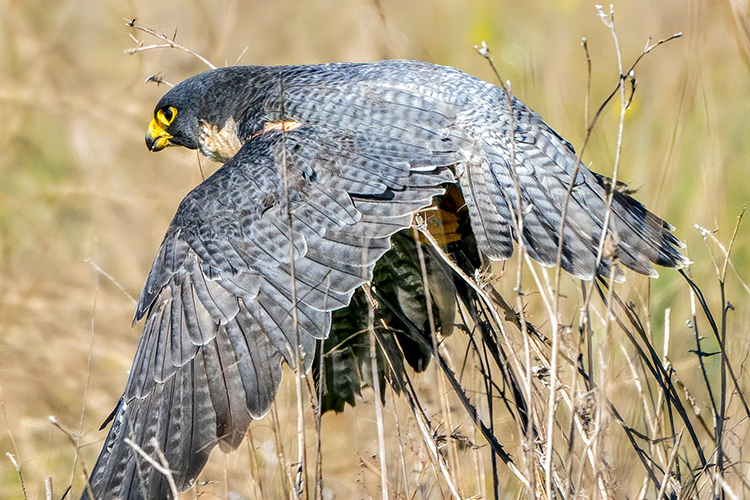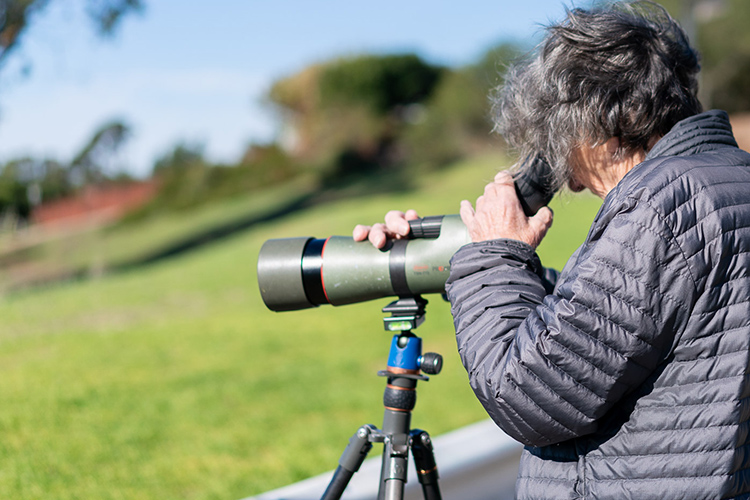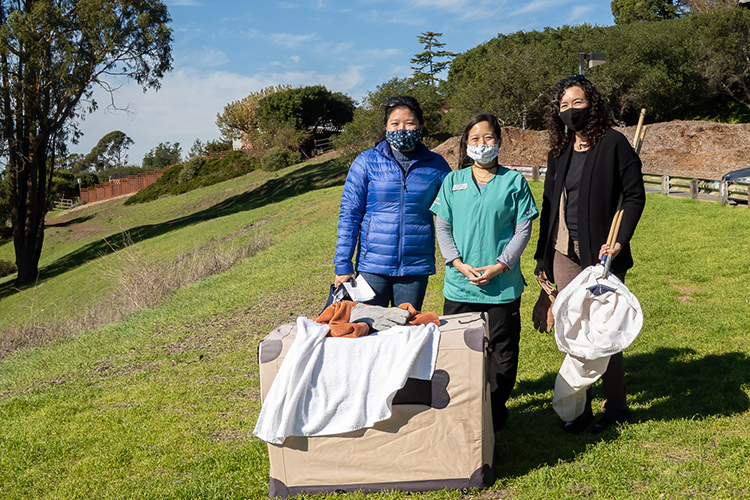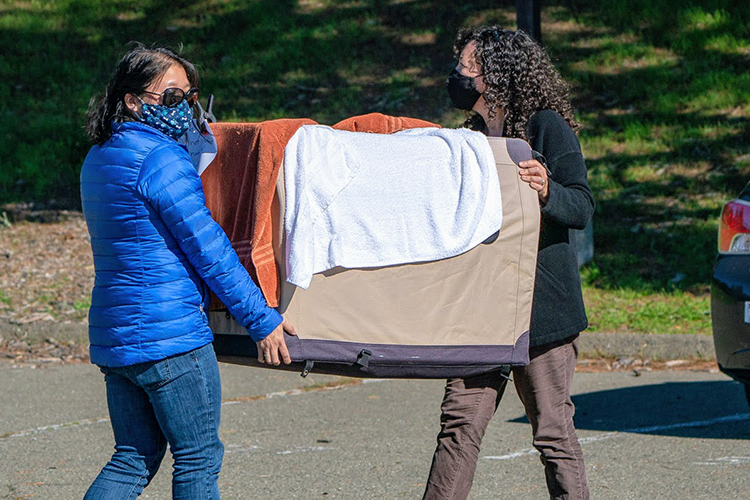He’s back! Grinnell, UC Berkeley’s male falcon, returns to the Campanile
But what happens next is anyone's guess. Annie, his longtime mate, is paired up with Grinnell's attacker, and a fight could ensue.

November 17, 2021
Declaring him 95% healed, Dr. Krystal Woo opened the flap of a large canvas animal carrier today and released Grinnell, UC Berkeley’s male peregrine falcon, into the clear skies above the campus. From a grassy green overlook next to the Lawrence Hall of Science, Grinnell saw his territory in the distance and quickly soared off.
“That’s the goal, that they just go. And he did,” said Woo, dressed in medical scrubs and scanning the horizon to glimpse where her Lindsay Wildlife Rehabilitation Hospital patient, injured by rival falcons on Oct. 29, had flown.
Remarkably, within a few hours of his late morning release, Grinnell was spotted on the Campanile, where he has raised 13 chicks — one died in 2017 — with his longtime mate, Annie. The pair began living on the bell tower in late 2016.
“This is a huge achievement for Grinnell and for Lindsay,” said Mary Malec, a Cal Falcons member who monitors local raptor nests for the East Bay Regional Park District. She and other volunteers spent the day on campus, some at the Hearst Mining Circle, others near Evans Hall, and later, a few near Bancroft Library, trying to glimpse the whereabouts of Grinnell, Annie and the male and female interlopers involved in Grinnell’s attack.
Coincidentally, the Cal Band was performing below the Campanile right when Grinnell returned, said Sean Peterson, an ornithologist and a member of Cal Falcons. “It was kind of hilarious that he was welcomed back to the Campanile with literal fanfare,” he said.
But while Grinnell is back, and back to health — except for a few remaining scrapes on a wing — the raptor’s fate is uncertain, and “that’s what I’m afraid of,” said Woo. Like others who observed Grinnell’s release, the veterinarian worries that, back at the Campanile, he’ll wind up fighting a second time with the male rival now courting Annie.
And Annie is very receptive to the newcomer.
“They fly together, they soar together. He lands, she lands. He flies, she flies,” said Malec of Annie and the male rival, who has all but moved in. “They’re bowing and chupping to each other.”
Falcons typically mate in January or February, said ornithologist Lynn Schofield, who also is on the Cal Falcons team, but added that they’ve been known to mate out of season.

Grinnell has only two imperatives, said Cal Falcons’ Mary Malec. “No. 1 is survival. No. 2 is to reproduce, if he survives.” (Photo by Bridget Ahern)
Malec said three falcons were seen flying together to the north, possibly two escorting one away from the tower, a short time after Grinnell’s release. But if the falcon being pursued was Grinnell, Malec said there’s no doubt that Grinnell returned to the Campanile twice this afternoon.
Still, the ending to what has been a soap opera above campus is likely to play out for many days. Whether it will lead to another battle is anyone’s guess.
“Wildlife happens. It’s out of our control, really,” said Doug Bell, a Berkeley alumnus who is wildlife program manager for the East Bay Regional Parks District. He came to campus today to watch Grinnell’s release.
“The good news,” he said, “is that there is a ‘floater’ population of adult peregrines out there that is not breeding yet.” In 1970, the American peregrine falcon was listed as endangered because of the pesticide DDT, which was banned in 1972. There were no falcons in the Bay Area in 1970, said Bell, but today, the 50 nests between Half Moon Bay and Pt. Reyes mean 50 pairs of peregrines.
Nonetheless, Malec said that, although she slept last night, “I can’t breathe today,” and called the release of Grinnell “the most stressful” release of a wild bird that she’s ever witnessed. Grinnell and Annie have been followed closely for years by fans in more than 40 countries and are beloved by the campus community. Volunteers like Malec provide countless hours monitoring Berkeley’s falcons, especially in late spring, when the fledglings take their first flights off the tower.
Malec called Grinnell “a good peregrine” and added that “he has only two imperatives: No. 1 is survival. No. 2 is to reproduce, if he survives.”
There have been battles between rival falcons that have lasted for days in a territory, she said. Grinnell’s accomplishment today — returning home — “is a good result so far,” said Malec, “but it’s not wrapped up.”
Said Peterson, who admitted to being “pretty nervous for the past few days” about Grinnell’s release, “It sounds like the matter of territory ownership is still far from settled, but I’m hopeful it will be solved without more injuries to any of the birds.”
Just in case, Malec said she planned to be on campus tonight, and in the coming days, ready to rescue any injured falcon.






